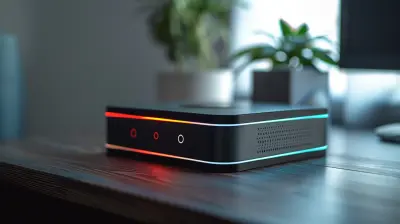Exploring the World of 6G: Beyond Faster Speeds
21 October 2025
So, you've heard of 5G, right? The blazing-fast network that’s been all the rage lately? Well, buckle up because here comes 6G, and it's not just about faster speeds. If you think 6G is simply an upgrade that’ll make your phone stream Netflix faster, you’re in for a surprise. We’re diving deep into the world of 6G, where the possibilities go far beyond what we’ve seen so far. Ready to take a look at what's on the horizon? Let's get started!

What Is 6G?
Before we start envisioning all the amazing things 6G could do, it’s probably a good idea to define what 6G is. Simply put, 6G stands for the sixth generation of mobile network technology. It’s the next step after 5G, but it’s much more than just a faster connection. With 6G, we’re looking at a complete transformation of how we interact with technology, the internet, and each other.Now, I know what you’re thinking: "I’m still waiting for 5G to fully roll out. Why are we talking about 6G already?" Fair point. But tech evolves at breakneck speed, and while 5G is still in its early stages, researchers and companies are already laying the groundwork for 6G. The goal is to have it ready for commercial use around 2030. Yeah, it sounds far off, but trust me, there’s a lot to be excited about.
6G vs. 5G: What’s the Difference?
You might be wondering how 6G will really differ from 5G. After all, 5G already boasts impressive features like ultra-low latency, faster download speeds, and the ability to connect many devices at once. But 6G is set to go even further.Speed
Yes, 6G will be faster—no surprises there. In fact, some estimates suggest we could be looking at speeds up to 100 times faster than 5G. That means downloading a full-length 4K movie could take just seconds. But let’s be real: speed is just the tip of the iceberg.Latency
If you thought 5G’s low latency (we’re talking milliseconds here) was impressive, 6G aims to reduce that even further. We’re talking about a latency so low that it’s virtually imperceptible. Imagine playing an online game where your actions are mirrored in real-time with zero lag. Or driving a self-driving car that can make split-second decisions instantly. That’s what 6G promises.Connectivity
One of the coolest things about 6G is that it won’t just connect your phone, smartwatch, and maybe your fridge if you’re into smart appliances. 6G will connect everything. And I mean EVERYTHING. We’re talking about billions upon billions of devices—from the tiniest sensors to massive industrial machines—all communicating seamlessly.
Beyond Faster Speeds: What 6G Will Enable
Okay, so faster speeds and better connectivity sound great, but what can 6G actually do that 5G can't? Let’s explore some of the game-changing possibilities that go way beyond just quicker downloads.1. Holographic Communication
Ever dreamed of having a Star Wars-style hologram conversation? With 6G, that could become a reality. The insane bandwidth and low latency of 6G will allow for real-time holographic video calls. Imagine chatting with a friend, and instead of seeing them on a flat screen, you’re interacting with a full 3D hologram right in front of you. The future is looking very sci-fi, right?This could revolutionize industries like healthcare, where doctors could remotely assess patients via holograms, or education, where students could learn hands-on with virtual tools. It’s not just about talking face-to-face; it’s about breaking the barriers of physical space.
2. The Internet of Everything (IoE)
You’ve probably heard of the Internet of Things (IoT), where everyday objects like your thermostat, lightbulbs, or even your coffee machine are connected to the internet. But 6G will bring us something even bigger: the Internet of Everything (IoE).IoE will connect not just devices but also data, people, and processes. Imagine a world where your car talks to traffic lights, your smartwatch monitors your health in real-time and alerts your doctor before you even realize something’s wrong, and your house adjusts its temperature and lighting based on your mood. With 6G, all of this could become possible, creating a seamlessly interconnected world.
3. AI-Driven Networks
Artificial Intelligence (AI) and 6G will go hand in hand. Unlike 5G, where AI is mostly used to improve network performance, 6G networks will be AI-native. This means that AI will not just optimize the network but will be a core part of it.AI-driven networks will be able to self-optimize, making them more efficient, smart, and adaptive. They’ll automatically adjust to ensure the best performance based on the user’s needs and environment. For instance, your network could prioritize certain tasks—like a video call—over less critical ones such as background app updates. It’s like having a personalized network tailored to your every need.
4. Enhanced Virtual and Augmented Reality (VR/AR)
While VR and AR are already making their way into our daily lives, 6G will take these technologies to a whole new level. With ultra-low latency and immersive visuals, AR and VR will feel more real than ever. You could walk around a virtual world that feels as responsive and tactile as the real one, or use AR glasses that provide real-time information about everything you look at in the real world.For instance, imagine walking down a city street, and your AR glasses display reviews of the restaurant you’re passing by or give you detailed directions to your destination. Or attending a concert where you use VR to feel like you’re right there on stage with your favorite artist. The possibilities are endless.
5. Smart Cities and Autonomous Systems
6G will be a driving force behind smart cities, where everything from traffic management to waste disposal is optimized through real-time data. Self-driving cars, drones, and even robots will be able to operate with greater precision and safety thanks to the ultra-reliable low-latency communication (URLLC) that 6G will provide.Imagine a city where traffic jams are a thing of the past because all vehicles are connected and able to communicate with each other to optimize routes. Or a hospital where surgery can be performed remotely through robotic arms controlled by a doctor miles away, with zero lag. That’s the kind of futuristic city 6G will help build.

Challenges and Roadblocks Ahead
While 6G sounds like a dream come true, it’s not without its challenges. Developing a technology this advanced requires overcoming several hurdles, both technical and societal.1. Infrastructure
Building out the infrastructure for 6G will be no small feat. We’re talking about a whole new level of hardware, from base stations to satellites. Plus, the frequencies that 6G will use (likely in the terahertz range) will require shorter transmission ranges, meaning we’ll need more cell towers and satellite networks to ensure global coverage.2. Power Consumption
With all this increased connectivity, there’s also the issue of power consumption. 6G networks will require huge amounts of energy to function, and ensuring that this energy is sourced sustainably will be a key challenge. The tech world will need to find ways to balance the need for faster, better networks with the need to protect our planet.3. Security and Privacy
As with any new technology, 6G brings up concerns about security and privacy. With so many devices connected and so much data flowing through the network, ensuring that information stays private and secure will be a top priority. Cybersecurity will need to evolve alongside 6G to keep up with the potential risks.
The Road to 2030: When Will 6G Be Available?
While 6G is still in the research and development phase, most experts predict that we’ll start seeing the first commercial 6G networks around 2030. That might feel like a long way off, but the groundwork is already being laid by companies like Samsung, Nokia, and Huawei, as well as academic institutions and governments around the world.In the meantime, we’ll continue to enjoy the benefits of 5G as it becomes more widespread. But it’s exciting to think about what the future holds, and how 6G could change the way we interact with the world around us.
Conclusion: 6G—More Than Just Faster Speeds
So, there you have it—6G is coming, and it promises to be a game-changer in ways that go far beyond faster downloads. From holographic communication to smart cities and AI-driven networks, 6G will revolutionize how we live, work, and play. While we still have a few years to wait, it’s clear that the future of connectivity is bright, and 6G will be at the heart of it.Are you ready for the 6G revolution? It’s coming faster than you think!
all images in this post were generated using AI tools
Category:
Emerging TechnologiesAuthor:

Vincent Hubbard
Discussion
rate this article
1 comments
Xena West
This article effectively highlights the potential of 6G technology beyond just speed improvements, emphasizing its role in enhancing connectivity, enabling new applications, and addressing challenges like energy consumption and infrastructure. It's an exciting glimpse into a future that could revolutionize our digital experiences.
October 23, 2025 at 12:29 PM

Vincent Hubbard
Thank you for your insightful comment! I'm glad you found the article highlights the broader potential of 6G technology. Exciting times ahead!


